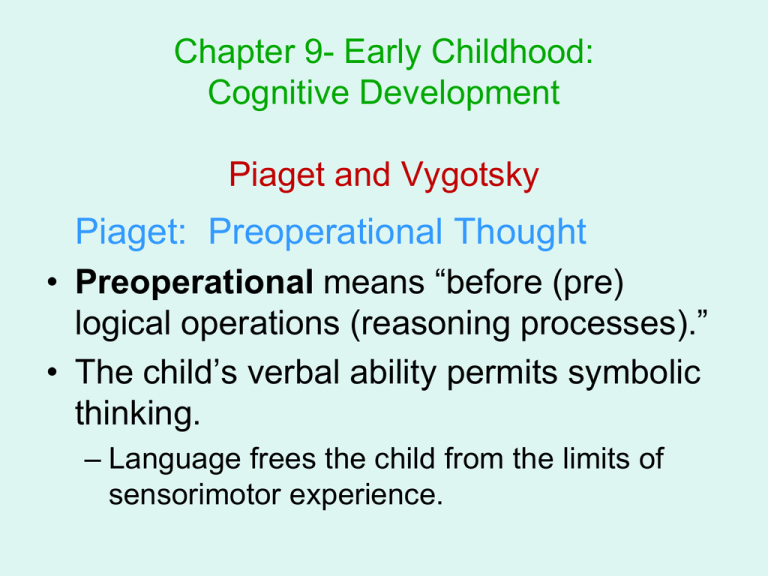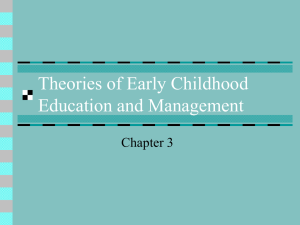Piaget: Preoperational Thought
advertisement

Chapter 9- Early Childhood: Cognitive Development Piaget and Vygotsky Piaget: Preoperational Thought • Preoperational means “before (pre) logical operations (reasoning processes).” • The child’s verbal ability permits symbolic thinking. – Language frees the child from the limits of sensorimotor experience. Piaget and Vygotsky Four Limitations of Preoperational Thought • Centration- a young child focuses (centers) on one idea, excluding all others. – Egocentrism- “self-centeredness” • Focus on appearance- a thing is whatever it appears to be • Static reasoning- belief that the world is unchanging • Irreversibility- what is done cannot be undone Piaget and Vygotsky • Conservation- The principle that the amount of a substance remains the same (is conserved) when its appearance changes. Piaget and Vygotsky •Animism- Belief that natural objects and phenomena are alive. •Children simultaneously hold rational and magical ideas. Piaget and Vygotsky Vygotsky: Social Learning • Every aspect of children’s cognitive development is embedded in the social context. • Guided participation- process by which people learn from others who guide their experiences and explorations (mentor). Piaget and Vygotsky • Zone of proximal development (ZPD)Vygotsky’s term for the skills—cognitive as well as physical—that a person can exercise only with assistance, not yet independently. • Scaffolding- Temporary support that is tailored to a learner’s needs and abilities and aimed at helping the learner master the next task in a given learning process. Language as a Tool • Private speech- The internal dialogue that occurs when people talk to themselves (either silently or out loud). • Social mediation- Human interaction that expands and advances understanding, often through words that one person uses to explain something to another. Children’s Theories • Theory-theory- The idea that children attempt to explain everything they see and hear using theories • Theory of mind- A person’s theory of what other people might be thinking. – In order to have a theory of mind, children must realize that other people are not necessarily thinking the same thoughts that they themselves are. – That realization is seldom achieved before age 4. Language • Language is pivotal to every kind of cognition in early childhood. • Early childhood is a sensitive period, the best time to master vocabulary, grammar, and pronunciation. • The average child knows about 500 words at age 2 and more than 10,000 at age 6. Language Fast-mapping •The speedy and sometimes imprecise way in which children learn new words by tentatively placing them in mental categories according to their perceived meaning. Language Language Basic Grammar • The grammar of a language includes the structures, techniques, and rules that communicate meaning. Word order and word repetition, prefixes and suffixes, intonation and emphasis—all are part of grammar. • Overregularization- The application of rules of grammar even when exceptions occur, making the language seem more “regular" than it actually is. Learning Two Languages • Young bilinguals site both languages in the same areas of the brain but keep them separate when speaking, not so in adults • Pronunciation is hard to master after childhood • Balanced Bilingual: fluent in two languages, not favoring one over the other Early Childhood Education Child-Centered Programs • Stress children’s natural inclination to learn through play rather than by following adult directions. • Show the influence of Vygotsky, who thought that children learn from other children and through cultural practices that structure life. • Montessori schools emphasize individual pride and accomplishment, presenting literacy-related tasks. • Reggio Emilia approach- A famous program of earlychildhood education that originated in the town of Reggio Emilia, Italy; it encourages each child’s creativity in a carefully designed setting. Early Childhood Education • • • • Teacher-Directed Programs Stress academic subjects taught by a teacher to an entire class. Children learn letters, numbers, shapes, and colors, as well as how to listen to the teacher and sit quietly. Make a clear distinction between work and play. Are much less expensive, since the child/adult ratio can be higher. Early Childhood Education Intervention Programs • Project Head Start- The most widespread early-childhood education program in the United States, begun in 1965 and funded by the federal government. • At first, the program was thought to be highly successful at raising children’s intelligence; ten years later, early gains were said to fade.







